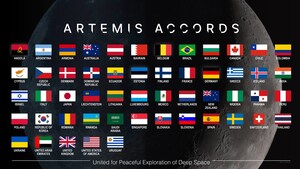WASHINGTON, Aug. 30, 2011 /PRNewswire-USNewswire/ -- NASA has established an astrophysics technology fellowship named for the woman many credit as one of the key contributors in the creation of the Hubble Space Telescope.
(Logo: http://photos.prnewswire.com/prnh/20081007/38461LOGO)
The Nancy Grace Roman Technology Fellowship in Astrophysics is designed to foster technologies that advance scientific investigations in the origin and physics of the universe and future exoplanet exploration. The fellowship will help early career researchers develop innovative technologies to enable scientific breakthroughs, while creating the skills necessary to lead astrophysics projects and future investigations. It also will foster and support early-career instrument builders on the path to long-term positions.
"The Roman fellowship is an important opportunity to infuse new ideas and technologies into frontier research areas as diverse as dark energy, black holes and life elsewhere in the universe," said Jon Morse, astrophysics division director at NASA Headquarters in Washington. "This will be the most substantial fellowship at five years, compared to others that typically run two to three years."
Beginning Nov. 18, early-career researchers may submit proposals for one-year concept studies for the development of new astrophysics technologies. Following a NASA review of the proposals, three to six applicants will be chosen for one-year fellowships to develop their concepts. Based on peer-review of the reports from the one-year studies, NASA will then select the fellows to implement the proposed technologies for up to four additional years.
The first selection of fellows will be announced during February 2012. Finalists selected in early 2013 to execute their projects over four years will receive up to $1 million in funding.
The fellowship's namesake is a distinguished American astronomer. Her celebrated career included multiple scientific and technical achievements at NASA and her important contributions to the design of the Hubble Space Telescope.
"The exciting results from the Hubble, other satellites and probes would not have been possible without innovative solutions to many technical problems," Roman said. "Just as the lunar landings inspired many young people to consider careers in space and related fields, the solution of the challenging instrumentation problems presented in space science can inspire young people to push beyond the current state of the art."
Born in Nashville, Tenn. in 1925, Roman studied science and earned her doctorate in astronomy from the University of Chicago in 1949. She became NASA's first chief of astronomy in 1959. As part of her new job, Roman travelled around the country, trying to understand what astronomers really wanted.
Roman set up a committee of astronomers and NASA engineers that eventually led to a detailed design for the Hubble. The telescope was launched April 24, 1990, aboard space shuttle's Discovery's STS-31 mission. Hubble's subsequent discoveries revolutionized nearly all areas of astronomical research from planetary science to cosmology.
Since retiring from NASA in 1979, Roman spends much of her time consulting, teaching and lecturing across the country in addition to being a passionate advocate for science.
The new technologies enabled by the fellowship will complement the innovative science at the core of NASA's other three astrophysics fellowships: the Sagan Fellowship created in 2009, focusing on exoplanet exploration; the Hubble Fellowship created in 1990, supporting research into cosmic origins; and the Einstein Fellowship created in 2009, enabling investigations on the physics of the cosmos.
NASA's Astrophysics Division mission seeks to understand the universe and our place in it. Missions investigate the very moment of creation of the universe; learn the full history of stars and galaxies; discover how planetary systems form and how environments hospitable for life develop; and search for the signature of life on other worlds.
For information about applying to the fellowship, visit:
For more information about NASA's astrophysics fellowships, visit:
http://science.nasa.gov/researchers/sara/student-programs/
For more information about NASA astrophysics programs, visit:
http://science.nasa.gov/astrophysics
SOURCE NASA
WANT YOUR COMPANY'S NEWS FEATURED ON PRNEWSWIRE.COM?
Newsrooms &
Influencers
Digital Media
Outlets
Journalists
Opted In





Share this article